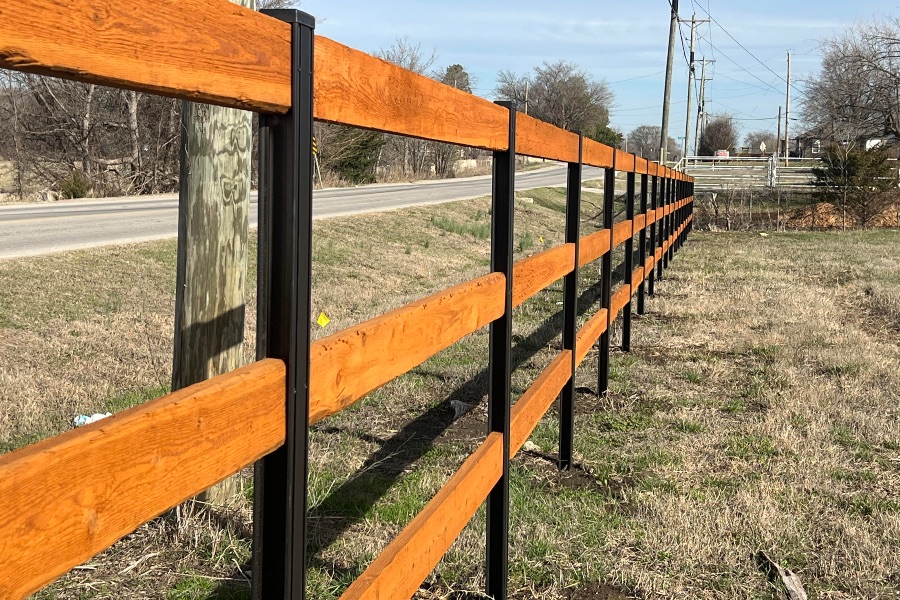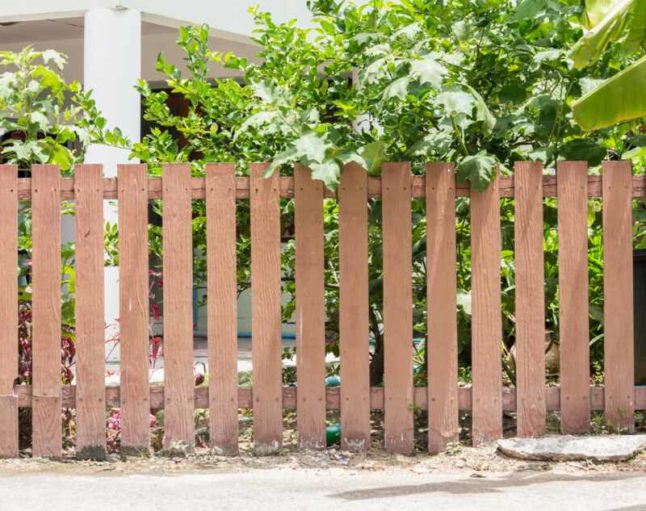All Categories
Featured
Fencings are essential structures that provide privacy, safety and security, and aesthetic charm to your property. Nonetheless, they are also revealed to the components and can experience damage from climate condition like rain, wind, sunlight, and snow. Whether you have a wood, plastic, steel, or composite fence, taking steps to secure it from the weather will certainly lengthen its life and protect its appearance. Here are several means you can protect your fencing from weather-related damage.
![]()
Wood Fences: Wood is at risk to rot, bending, and insect problems when revealed to dampness. If you select a wood fencing, select products like cedar or redwood, which are normally a lot more resistant to the aspects. Additionally, opt for pressure-treated wood, which has been chemically treated to withstand rot and insects. Vinyl Fencings: Plastic fences are very resistant to the elements. They will not rot, warp, or split like wood, and they are immune to insect damage. Plastic is also UV-resistant, so it doesn't fade in the sunlight as rapidly as other materials. Steel Fencings: Wrought iron and aluminum fencings are sturdy and immune to many weather problems. Nevertheless, metal can rust if revealed to moisture for long term durations. Ensure it is powder-coated or galvanized to protect against rusting if you have a steel fencing. Composite Fences: Composite fencings integrate wood fibers and plastic, using the appearance of wood with boosted durability. They are resistant to rot, pests, and fading, making them an excellent option for regions with extreme weather. 2. Apply Protective Coatings and Sealants. Using safety layers to your fence can protect against wetness and UV damage, substantially prolonging its life expectancy.
Wooden Fencings: To secure timber from dampness and UV rays, use a top notch sealer or discolor. These finishings work as a barrier, protecting against water from saturating right into the wood and creating rot. Furthermore, they protect against sun damage that can trigger fading and cracking. Make sure to reapply the tarnish or sealer every couple of years, depending upon the climate and the problem of the fence. Plastic Fences: Although vinyl fences are very sturdy, they can still discolor gradually as a result of UV exposure. You can use a UV protectant to keep your vinyl fence resembling brand-new. In addition, normal cleaning with a vinyl-safe cleaner can help stop staining and staining. Steel Fences: Metal fencings, particularly those made from iron or steel, can rust gradually. A rust-resistant primer adhered to by a coat of weather-resistant paint will certainly assist shield against corrosion. For included defense, think about powder coating, which offers a resilient, long-lasting surface that resists corrosion and scratches. 3. Normal Cleansing and Maintenance. Keeping your fence tidy and well-kept is among the most reliable ways to stop weather-related damages.
Wood Fencings: Dirt, debris, and mold and mildew can collect on wood fencings in time. Regular cleansing with a moderate soap remedy or stress washer can aid protect against the accumulation of gunk. Be sure to evaluate the timber for signs of damages such as rot or splitting and address concerns quickly. Vinyl Fences: Plastic fencings are low-maintenance, but they can gather dust, leaves, and various other particles. To cleanse a vinyl fencing, simply hose it down or clean it with soapy water. For tougher discolorations, utilize a soft towel with a vinyl-safe cleanser. Steel Fencings: Steel fencings can collect dirt, dirt, and rust, particularly after a tornado. Clean the fence routinely using a non-abrasive cloth and moderate soap. Remove any rust quickly with a cable brush or corrosion cleaner to prevent it from spreading. 4. Install a Fencing Base Guard. For fences subjected to heavy rain or snow, mounting a fencing base guard can prevent wetness from permeating the bottom of your fencing blog posts. This is particularly important for composite and wood fences, as water exposure at the base of the fence can cause decaying or degeneration.
In addition to base guards, take into consideration utilizing crushed rock or a moisture-resistant obstacle around the base of wood posts. This will allow water to recede from the base of the posts and lower the risk of rot.
![]()
Frequently trim plants and trees that are near the fence. This will certainly aid maintain the fencing completely dry, prevent unwanted stress on the framework, and guarantee that air circulates around the posts.
For metal fencings, check for corrosion prior to the cold weather and treat any type of afflicted locations. You can additionally apply a safety covering to stop snow and ice from creating deterioration.
![]()
Conclusion. Securing your fencing from weather-related damages is important to guaranteeing its long life and effectiveness. By choosing the ideal products, using protective coverings, keeping your fencing clean, and taking proactive upkeep steps, you can stop numerous of the common problems that develop from exposure to the components. Whether you have a wooden, plastic, metal, or composite fencing, these actions will certainly help protect your investment and keep your fence looking excellent for several years to come.

- Pick Weather-Resistant Products. The material of your fence plays a considerable role in its capacity to withstand numerous weather. Selecting a material that fits your climate can help minimize weather-related damages.
Wood Fences: Wood is at risk to rot, bending, and insect problems when revealed to dampness. If you select a wood fencing, select products like cedar or redwood, which are normally a lot more resistant to the aspects. Additionally, opt for pressure-treated wood, which has been chemically treated to withstand rot and insects. Vinyl Fencings: Plastic fences are very resistant to the elements. They will not rot, warp, or split like wood, and they are immune to insect damage. Plastic is also UV-resistant, so it doesn't fade in the sunlight as rapidly as other materials. Steel Fencings: Wrought iron and aluminum fencings are sturdy and immune to many weather problems. Nevertheless, metal can rust if revealed to moisture for long term durations. Ensure it is powder-coated or galvanized to protect against rusting if you have a steel fencing. Composite Fences: Composite fencings integrate wood fibers and plastic, using the appearance of wood with boosted durability. They are resistant to rot, pests, and fading, making them an excellent option for regions with extreme weather. 2. Apply Protective Coatings and Sealants. Using safety layers to your fence can protect against wetness and UV damage, substantially prolonging its life expectancy.
Wooden Fencings: To secure timber from dampness and UV rays, use a top notch sealer or discolor. These finishings work as a barrier, protecting against water from saturating right into the wood and creating rot. Furthermore, they protect against sun damage that can trigger fading and cracking. Make sure to reapply the tarnish or sealer every couple of years, depending upon the climate and the problem of the fence. Plastic Fences: Although vinyl fences are very sturdy, they can still discolor gradually as a result of UV exposure. You can use a UV protectant to keep your vinyl fence resembling brand-new. In addition, normal cleaning with a vinyl-safe cleaner can help stop staining and staining. Steel Fences: Metal fencings, particularly those made from iron or steel, can rust gradually. A rust-resistant primer adhered to by a coat of weather-resistant paint will certainly assist shield against corrosion. For included defense, think about powder coating, which offers a resilient, long-lasting surface that resists corrosion and scratches. 3. Normal Cleansing and Maintenance. Keeping your fence tidy and well-kept is among the most reliable ways to stop weather-related damages.
Wood Fencings: Dirt, debris, and mold and mildew can collect on wood fencings in time. Regular cleansing with a moderate soap remedy or stress washer can aid protect against the accumulation of gunk. Be sure to evaluate the timber for signs of damages such as rot or splitting and address concerns quickly. Vinyl Fences: Plastic fencings are low-maintenance, but they can gather dust, leaves, and various other particles. To cleanse a vinyl fencing, simply hose it down or clean it with soapy water. For tougher discolorations, utilize a soft towel with a vinyl-safe cleanser. Steel Fencings: Steel fencings can collect dirt, dirt, and rust, particularly after a tornado. Clean the fence routinely using a non-abrasive cloth and moderate soap. Remove any rust quickly with a cable brush or corrosion cleaner to prevent it from spreading. 4. Install a Fencing Base Guard. For fences subjected to heavy rain or snow, mounting a fencing base guard can prevent wetness from permeating the bottom of your fencing blog posts. This is particularly important for composite and wood fences, as water exposure at the base of the fence can cause decaying or degeneration.
In addition to base guards, take into consideration utilizing crushed rock or a moisture-resistant obstacle around the base of wood posts. This will allow water to recede from the base of the posts and lower the risk of rot.

- Trim Plant Life Around Your Fence. Trees, plants, and hedges growing too near to your fencing can create considerable weather-related damage. Disordered plant life can catch wetness versus the fence, advertising rot and mold growth. In addition, tree origins can push versus fencing blog posts, creating them to change or split.
Frequently trim plants and trees that are near the fence. This will certainly aid maintain the fencing completely dry, prevent unwanted stress on the framework, and guarantee that air circulates around the posts.
- Prepare Your Fencing for Winter. In regions with cold wintertimes, freezing temperature levels and ice can be particularly harming to wooden fences. Water that goes into the timber can freeze, triggering cracks and divides. To prevent this, make sure that your wood fence posts are properly sealed and raised above the ground to stop water from accumulating at the base.
For metal fencings, check for corrosion prior to the cold weather and treat any type of afflicted locations. You can additionally apply a safety covering to stop snow and ice from creating deterioration.

- Post-Storm Maintenance. After a hefty storm, check your fence for any kind of indicators of damage, such as loose posts, bent panels, or debris lodged in between slats. Even minor damage must be fixed swiftly to stop further deterioration. Enhance weak areas and change busted areas as quickly as feasible to keep its structural honesty. if your fence has actually been harmed by a tornado.
Conclusion. Securing your fencing from weather-related damages is important to guaranteeing its long life and effectiveness. By choosing the ideal products, using protective coverings, keeping your fencing clean, and taking proactive upkeep steps, you can stop numerous of the common problems that develop from exposure to the components. Whether you have a wooden, plastic, metal, or composite fencing, these actions will certainly help protect your investment and keep your fence looking excellent for several years to come.
Latest Posts
Specialist Industrial Roofing Solutions in North Platte, Nebraska
Published May 24, 25
2 min read
Explore Budget-Friendly Auto Repairs with Montclare’s Monthly Service Specials
Published May 24, 25
1 min read
Find the Greatest Auto Repair Discounts in Montclare, Chicago
Published May 24, 25
1 min read
More
Latest Posts
Specialist Industrial Roofing Solutions in North Platte, Nebraska
Published May 24, 25
2 min read
Explore Budget-Friendly Auto Repairs with Montclare’s Monthly Service Specials
Published May 24, 25
1 min read
Find the Greatest Auto Repair Discounts in Montclare, Chicago
Published May 24, 25
1 min read